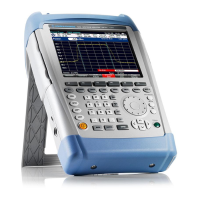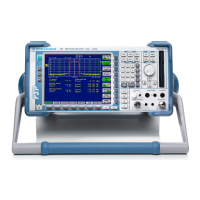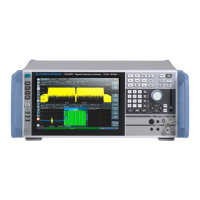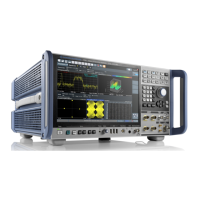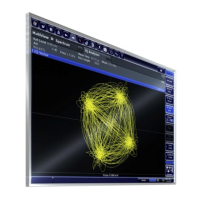
Do you have a question about the Rohde & Schwarz FSH13 and is the answer not in the manual?
| Frequency Range | 9 kHz to 13.6 GHz |
|---|---|
| Dynamic Range | > 100 dB |
| Battery Life | Approx. 4 hours |
| Amplitude Accuracy | ±0.5 dB |
| Frequency Resolution | 1 Hz |
| Input Impedance | 50 Ω |
| Storage Temperature Range | -40 °C to +70 °C |
| Weight | 2.5 kg (including battery) |
| Tracking Generator | Yes (option) |
| Third Order Intercept (TOI) | +15 dBm |
| Input Connector | N (female) |
| Operating Temperature Range | -10 °C to +50 °C |
Specifies conditions and positions for safe operation.
Instructions for safe electrical operation and connection.
Guidelines for operating the product safely, considering user fitness and environmental factors.
Information on authorized personnel and safety tests for repair.
Safety precautions for handling, storage, and disposal of batteries.
Methods for controlling the R&S FSH remotely from a PC.
Resets the R&S FSH settings to their default state.
Explains how to configure measurement settings using the dialog box.
Describes instrument setup and PIN protection system.
Steps to connect the R&S FSH to a PC using software package.
Instructions for setting up a LAN connection and IP address.
How to connect via DHCP in an existing LAN.
Steps to connect the R&S FSH to a PC using a USB cable.
Functionality to save, restore, and manage datasets.
How to save current measurement data as a dataset.
How to preview and load previously saved measurement results.
How to load a dataset to apply its settings for current measurement tasks.
How to delete single or multiple datasets using the file manager.
How to download and install new firmware versions from the R&S FSH website.
How to define and transfer measurement sets using R&S FSH4View.
How to create a measurement set using datasets and the Wizard Set Editor.
How to upload wizard definition files to the R&S FSH for actual measurements.
How to start and use the measurement wizard with loaded measurement sets.
Steps to initiate the measurement wizard and load measurement sets.
How to perform a sequence of measurements defined in a measurement set.
How to evaluate results and compile measurement reports using R&S FSH4View.
How to perform basic and specific spectrum measurements.
Measures power of a specific transmission channel, excluding other signals.
Measures bandwidth containing a specified percentage of transmitter's total power.
Measures power over one timeslot for TDMA signals.
Measures power over multiple channels and evaluates adjacent channel power.
Checks signal compliance against spectral mask for telecommunication standards.
Identifies harmonics and calculates Total Harmonic Distortion (THD).
Analyzes AM modulated signals and calculates modulation depth.
Monitors unwanted emissions outside assigned channels against a limit line.
Displays spectral density in frequency domain and over time simultaneously.
Sets up horizontal axis parameters for spectrum measurements.
Sets the input signal gain and position of the reference line.
Adjusts input range by setting RF attenuation in different modes.
Sets up filter bandwidths available in the R&S FSH.
Determines frequency resolution and affects noise and measurement speed.
Configures sweep settings, including time and mode.
Configures trigger sources (Free Run, Video, External) for measurements.
Controls and uses markers for analyzing signals.
Demodulates AM and FM signals to monitor audio characteristics.
Automatically checks trace against active limit lines and indicates pass/fail.
Turns R&S FSH into a wideband power meter for measuring signal power.
Connects directional power sensors for forward and reverse power measurements.
Configures frequency, weighting mode, units, and standard for directional power measurements.
Performs channel power measurements without a power sensor by connecting DUT directly.
Performs pulse power measurements using firmware option R&S FSH-K29.
Configures Power vs Time display and pulse measurement aspects.
Selects algorithms (Histogram, Integration, Peak) for base and top power calculation.
Determines if a signal has sufficient power compared to surrounding spectrum.
Determines signal impact from neighboring channels by measuring carrier to interference ratio.
Locates interferers using antennas and general setup controls.
Plays back audio signals that change volume/frequency based on received signal strength.
Locates interference sources by calculating the intersection of azimuth lines from two or more geotags.
Defines output level, offset, and frequency of the generated signal.
Measures magnitude of reflection and transmission characteristics.
Measures phase characteristics of DUTs with higher dynamic range and accuracy.
Measures transmission characteristics (S21) of a two-port filter.
Measures reflection characteristics (S11) of a two-port filter.
Selects measurement formats to view different aspects of results.
Adjusts scaling of the vertical axis for complete transmission function display.
Analyzes signal aspects to identify cable problems.
Determines exact location and degree of faults in transmission systems.
Calibrates measurements for best and most accurate results, considering test setup.
Describes calibration methods for distance-to-fault mode (1-port calibration).
Specifies cable characteristics like model and frequency range for valid results.
Defines frequency and distance parameters for cable measurements.
Specifies cable length to determine span and calculate cable attenuation.
Adjusts vertical axis scale for measurement diagrams.
Measures power across a defined set of frequencies in a graphical display.
Configures receiver measurements, including detectors and bandwidths for EMI.
Selects detectors (Max Peak, Average, RMS, Quasi Peak) for EMI measurements.
Adds 6 dB resolution bandwidths for CISPR16 measurements.
Configures trace display and mathematics in Receiver mode.
Performs measurements on downlink GSM signals according to 3GPP standard.
Performs WCDMA signal measurements according to 3GPP standard.
Performs measurements on downlink CDMA2000 signals according to 3GPP2 standard.
Performs measurements on downlink 1xEV-DO signals according to 3GPP2 standard.
Identifies base stations by PN offset and shows their power graphically and numerically.
Shows signal power over a single 1xEV-DO frame (26.66 ms).
Performs measurements on downlink TD-SCDMA signals according to 3GPP standard.
Provides code domain analysis to visualize signal results in a diagram.
Visualizes channel structure, parameters, and results on code channel level.
Performs measurements on downlink LTE FDD and TDD signals.
Defines and analyzes characteristics of up to five component carriers.
Visualizes transmitted symbol locations in the complex plane for modulation quality.
Identifies base stations by Cell ID and shows their power graphically and numerically.
Visualizes resource allocation and power of each resource element.
Lists all softkeys and menus available in spectrum analyzer mode.
Opens measurement menu to select and configure measurements.
Lists all softkeys and menus available in network analyzer mode.
Lists all softkeys and menus available in power meter mode.
Configures measurements with the power meter.
Lists all softkeys and menus available in distance-to-fault mode.
Lists all softkeys and menus available in receiver mode.
Controls markers and uses marker functions.
Lists softkeys and menus for interference analyzer maps mode.
Lists softkeys and menus for digital modulation mode.
Selects and configures measurements for digital modulation.
Configures measurements for GSM signals.
Configures measurements for 3GPP WCDMA signals.
Sets up the horizontal axis of the measurement diagram.
Sets up the vertical axis of the measurement diagram.
Configures sweep settings.
Sets up traces.
